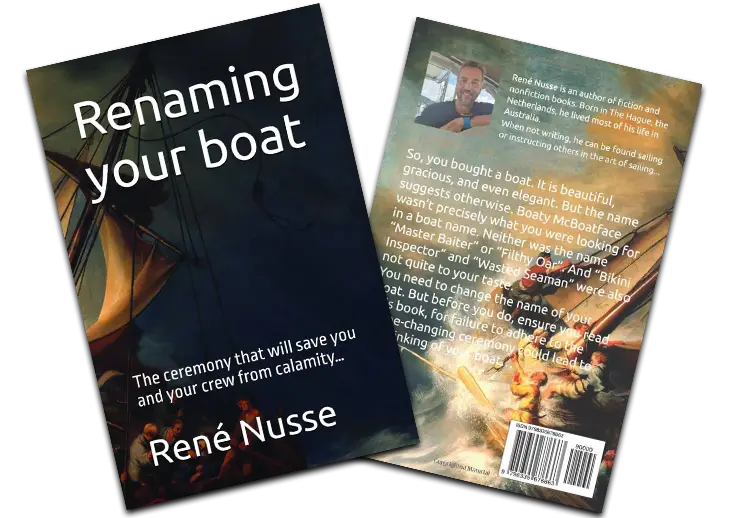Starting Sequence Flags and Sound Signals
In a sailing race, the starting sequence is signalled through a combination of flags and sound signals, which indicate key moments leading up to the race’s start. This process is governed by the Racing Rules of Sailing (RRS) and perhaps modified by the Sailing Instructions (SIs) and typically involves a countdown procedure. Below are the key flags and sound signals used during the start of a sailing race.
The meanings of visual and sound signals are stated below. An arrow pointing up or down (↑ ↓) means a visual signal is displayed or removed. A dot (•) represents a sound; five short dashes (– – – – –) mean repetitive sounds; a long dash (—) indicates a long sound. When a visual signal is displayed over a class flag, the signal applies only to that class.
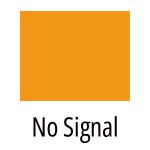
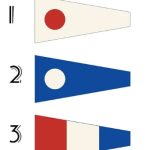

 These are typically displayed just below the course flag… So now you know your course as well as how to round each of the marks on your course.
These are typically displayed just below the course flag… So now you know your course as well as how to round each of the marks on your course.
 As soon as this is raised, you know there are only 5 minutes left to the start of the race.
As soon as this is raised, you know there are only 5 minutes left to the start of the race.
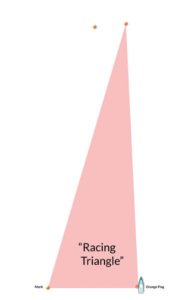
 Only the P flag is shown, but as explained, it could be the I, Z, U, or Black flag. If you are early over the line, your sail or hull number will be displayed on the back of the start boat with the applicable penalty.
4. Starting Signal
Only the P flag is shown, but as explained, it could be the I, Z, U, or Black flag. If you are early over the line, your sail or hull number will be displayed on the back of the start boat with the applicable penalty.
4. Starting Signal
 If we stick with the example above and sail Tasars, your class flag will be dropped, and you will also hear a long horn blast. Note that the flag determines the start of the race, not the sound signal. They “should” naturally happen simultaneously.
If we stick with the example above and sail Tasars, your class flag will be dropped, and you will also hear a long horn blast. Note that the flag determines the start of the race, not the sound signal. They “should” naturally happen simultaneously.
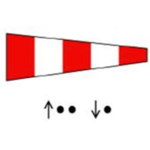
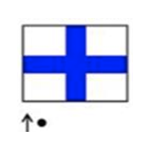 The RO will not indicate who crossed the line early, so it is up to the individual sailor to determine if it was him or her. If you think you were early, you must sail around the start line and start again.
The RO will not indicate who crossed the line early, so it is up to the individual sailor to determine if it was him or her. If you think you were early, you must sail around the start line and start again.
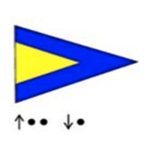 This is often shown if multiple boats are over the start line before the start. Identifying individuals would be too hard, so a restart is ordered. Usually, if this happens, we will see a different preparatory flag in the following starting sequence with more severe penalties attached to ensure that it will not happen again.
This is often shown if multiple boats are over the start line before the start. Identifying individuals would be too hard, so a restart is ordered. Usually, if this happens, we will see a different preparatory flag in the following starting sequence with more severe penalties attached to ensure that it will not happen again.
A. Orange Flag (Race is starting soon)
- Flag: Orange.
- Sound Signal: No sound signal.
- Time Remaining: This has not been determined, but a kind Race Officer (RO) will raise this 5 minutes before the starting sequence begins.
- Meaning: Race is soon to start, and the orange flag designates one side of the start line.

You know a race is imminent as soon as you see the orange flag. Pay close attention to what flags are displayed next and organise your starting approaches.
B. The course flag
- Flag: Numerical nautical flags.
- Sound Signal: No sound signal.
- Time Remaining: This has not been determined.
- Meaning: Designate the course you will be racing.

C. Mark rounding side flags
- Flag: Green triangle or red square
- Sound Signal: No sound signal.
- Time Remaining: This has not been determined.
- Meaning: Designate the side you should round the marks on your course.

 These are typically displayed just below the course flag… So now you know your course as well as how to round each of the marks on your course.
These are typically displayed just below the course flag… So now you know your course as well as how to round each of the marks on your course.
The starting Sequence
Now that we know what course to sail, we must keep our eyes and ears open for the starting sequence. This is usually a five-minute sequence but can be shortened if the SI says so.1. Class Flag (Race Start Sequence Begins)
- Flag: Simply the class you are sailing in.
- Sound Signal: One long sound (horn or whistle)
- Time Remaining: 5 minutes before the start.
- Meaning: Signals the start of the countdown for that class or fleet.
For example, if you are sailing Tasars, your class flag should look like this (without the sound symbols):
 As soon as this is raised, you know there are only 5 minutes left to the start of the race.
As soon as this is raised, you know there are only 5 minutes left to the start of the race.
Preparatory Flags
2. Preparatory Flag (P Flag)
- Flag: A blue square flag with a white centre.
- Sound Signal: One long sound.
- Time Remaining: 4 minutes before the start.
- Meaning: Boats are now in their preparatory phase and must avoid crossing the starting line early.

- I Flag: If raised, boats that cross the starting line early must return by sailing around one of the ends of the starting line before starting.
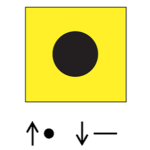 “30.1 STARTING PENALTIES
I Flag Rule
If flag I has been displayed, and any part of a boat’s hull is on the course side of the starting line or one of its extensions during the last minute before her starting signal, she shall sail across an extension so that her hull is completely on the pre-start side before she starts.”
“30.1 STARTING PENALTIES
I Flag Rule
If flag I has been displayed, and any part of a boat’s hull is on the course side of the starting line or one of its extensions during the last minute before her starting signal, she shall sail across an extension so that her hull is completely on the pre-start side before she starts.”
- Z Flag: If raised, any boat crossing the starting line early during the last minute of the countdown gets a 20% penalty.
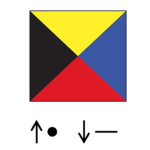 “30.2 STARTING PENALTIES
Z Flag Rule
If flag Z has been displayed, no part of a boat’s hull shall be in the triangle formed by the ends of the starting line and the first mark during the last minute before her starting signal. If a boat breaks this rule and is identified, she shall receive, without a hearing, a 20% Scoring Penalty calculated as stated in rule 44.3(c). She shall be penalized even if the race is restarted or resailed, but not if it is postponed or abandoned before the starting signal. If she is similarly identified during a subsequent attempt to start the same race, she shall receive an additional 20% Scoring Penalty.”
“30.2 STARTING PENALTIES
Z Flag Rule
If flag Z has been displayed, no part of a boat’s hull shall be in the triangle formed by the ends of the starting line and the first mark during the last minute before her starting signal. If a boat breaks this rule and is identified, she shall receive, without a hearing, a 20% Scoring Penalty calculated as stated in rule 44.3(c). She shall be penalized even if the race is restarted or resailed, but not if it is postponed or abandoned before the starting signal. If she is similarly identified during a subsequent attempt to start the same race, she shall receive an additional 20% Scoring Penalty.”
- U Flag: If raised, any boat crossing the starting line early during the last minute of the countdown will be disqualified from the race without a hearing.
 “30.3 STARTING PENALTIES
U Flag Rule
If flag U has been displayed, no part of a boat’s hull, crew or equipment shall be in the triangle formed by the ends of the starting line and the first mark during the last minute before her starting signal. If a boat breaks this rule and is identified, she shall be disqualified without a hearing, but not if the race is restarted or resailed.”
“30.3 STARTING PENALTIES
U Flag Rule
If flag U has been displayed, no part of a boat’s hull, crew or equipment shall be in the triangle formed by the ends of the starting line and the first mark during the last minute before her starting signal. If a boat breaks this rule and is identified, she shall be disqualified without a hearing, but not if the race is restarted or resailed.”
- Black Flag: If a boat crosses the starting line early under the Black Flag, they are disqualified from the race.
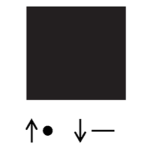 “30.4 STARTING PENALTIES
Black Flag Rule
If a black flag has been displayed, no part of a boat’s hull shall be in the triangle formed by the ends of the starting line and the first mark during the last minute before her starting signal. If a boat breaks this rule and is identified, she shall be disqualified without a hearing, even if the race is restarted or resailed, but not if it is postponed or abandoned before the starting signal. If a general recall is signalled or the race is abandoned after the starting signal, the race committee shall display her sail number before the next warning signal for that race, and if the race is restarted or resailed she shall not sail in it. If she does so, her disqualification shall not be excluded in calculating her series score.”
“30.4 STARTING PENALTIES
Black Flag Rule
If a black flag has been displayed, no part of a boat’s hull shall be in the triangle formed by the ends of the starting line and the first mark during the last minute before her starting signal. If a boat breaks this rule and is identified, she shall be disqualified without a hearing, even if the race is restarted or resailed, but not if it is postponed or abandoned before the starting signal. If a general recall is signalled or the race is abandoned after the starting signal, the race committee shall display her sail number before the next warning signal for that race, and if the race is restarted or resailed she shall not sail in it. If she does so, her disqualification shall not be excluded in calculating her series score.”

3. One-Minute Signal
- Flag: The Preparatory Flag (P, I, Z, U, or Black) is still up.
- Sound Signal: One long sound.
- Time Remaining: 1 minute before the start.
- Meaning: Indicates that the race will start in 1 minute. Any boat crossing the starting line early during this last minute (under certain flags) may face penalties.
 Only the P flag is shown, but as explained, it could be the I, Z, U, or Black flag. If you are early over the line, your sail or hull number will be displayed on the back of the start boat with the applicable penalty.
4. Starting Signal
Only the P flag is shown, but as explained, it could be the I, Z, U, or Black flag. If you are early over the line, your sail or hull number will be displayed on the back of the start boat with the applicable penalty.
4. Starting Signal
- Flag: Class Flag lowered.
- Sound Signal: One long sound.
- Time Remaining: 0 minutes.
- Meaning: The race has started. Boats can now legally cross the starting line.
 If we stick with the example above and sail Tasars, your class flag will be dropped, and you will also hear a long horn blast. Note that the flag determines the start of the race, not the sound signal. They “should” naturally happen simultaneously.
If we stick with the example above and sail Tasars, your class flag will be dropped, and you will also hear a long horn blast. Note that the flag determines the start of the race, not the sound signal. They “should” naturally happen simultaneously.
Additional Flags for Start-Related Incidents
1. Postponement Flag (AP Flag)
- Flag: Red and white vertical stripes.
- Sound Signal: Two long sounds.
- Meaning: The race has been postponed. The sequence will be delayed. One long sound will follow when the flag is lowered, and the 1-minute signal is restarted shortly afterwards.

2. Individual Recall Flag (X Flag)
- Flag: White flag with a blue cross.
- Sound Signal: One long sound.
- Meaning: Indicates that one or more boats started early. The offending boats must return to the pre-start side of the line and cross it properly to restart.
 The RO will not indicate who crossed the line early, so it is up to the individual sailor to determine if it was him or her. If you think you were early, you must sail around the start line and start again.
The RO will not indicate who crossed the line early, so it is up to the individual sailor to determine if it was him or her. If you think you were early, you must sail around the start line and start again.
3. General Recall Flag (First Substitute Flag)
- Flag: Blue and yellow triangle.
- Sound Signal: Two long sounds.
- Meaning: Indicates a general recall of the entire fleet due to multiple boats starting early or confusion at the start. The start sequence will be restarted.
 This is often shown if multiple boats are over the start line before the start. Identifying individuals would be too hard, so a restart is ordered. Usually, if this happens, we will see a different preparatory flag in the following starting sequence with more severe penalties attached to ensure that it will not happen again.
This is often shown if multiple boats are over the start line before the start. Identifying individuals would be too hard, so a restart is ordered. Usually, if this happens, we will see a different preparatory flag in the following starting sequence with more severe penalties attached to ensure that it will not happen again.
Summary of Signals
This combination of flags and sound signals ensures clear communication of the race start and any necessary adjustments or recalls. Many more signals for changing the course, shortening the course, etc., can all be found at the start of the 2025 – 2028 sailing racing rules. Remember, when there is a discrepancy, the flag signal counts, not the sound signal!
NAVIGATION RULES CLINIC + BASIC SAIL TRIM COURSE
These FREE online sailing lessons are a great refresher courses for EVERYONE.
Take these FREE courses now and check out how simple and easy it is to take a NauticEd online sailing course.Estimated time: 20 minutes each.
Author
-

Rene is a keelboat instructor and sailing coach in the Mandurah area WA. He is also the author of several books about sailing including "The Book of Maritime Idioms" and "Renaming your boat".
View all posts

